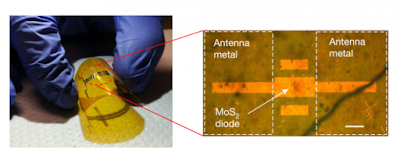We Don't Need No Stinking Batteries
 Kim BellardQuick: how many different power cords and chargers do you have for your various devices?
Kim BellardQuick: how many different power cords and chargers do you have for your various devices?
E.g., for your PC, smartphone, tablet, e-reader, or smartwatch. And how much time do you spend actually charging them, or looking for somewhere to charge them? It's likely that the answers are well in the more-than-I'd-like range.
All that may be changing, due to something called rectennas. More importantly, they may be what truly make the Internet-of-Things (IoT) possible. Healthcare is quite enamored about the possibilities of IoT -- not just wearables but smart pills, ingestibles, even tiny robots swimming around our bodies fixing problems. We'd be able to track and address in real-time or near-real-time what is happening with our bodies. It is truly exciting.
For example, these elastic robots can actually change their shape based on their surroundings [See video].
The researchers who developed them tested them specifically to mimic what it would be like to navigate through blood vessels with varying circumference and viscosity. The lead author, Selman Sakar, noted: "if they encounter a change in viscosity or osmotic concentration, they modify their shape to maintain their speed and maneuverability without losing control of the direction of motion."
Pretty impressive.
The problem with many IoT devices, though, is similar to with our other devices: what happens when the battery runs low? It's not easy to get a charger into our gut to repower smart pills, and for anyone worried about the ecological risks posed by computer or smartphone batteries, well, imagine tiny versions of those toxic batteries floating around in your body.
We'll need sensors to track the damage done by our other sensors' dead batteries.
 Credit-ExtremeTech
Credit-ExtremeTech
Not with rectennas. Rectennas are powered by Wi-Fi signals, like the kind you use in your house or at Starbucks to get internet access. This is not a new concept, but what is new is that MIT researchers have been able to harvest enough power to make them useful, in a device only a few atoms thick.
The research -- with the catchy title Two-dimensional MoS2-enabled flexible rectenna for Wi-Fi-band wireless energy harvesting --appeared in Nature.MIT Professor and paper co-author Tomás Palacios summed up its importance as follows:
What if we could develop electronic systems that we wrap around a bridge or cover an entire highway, or the walls of our office and bring electronic intelligence to everything around us? How do you provide energy for those electronics? We have come up with a new way to power the electronics systems of the future - by harvesting Wi-Fi energy in a way that's easily integrated in large areas - to bring intelligence to every object around us.
Rectennas catch AC electromagnetic waves, including Wi-Fi or Bluetooth, and transmit them to a "two-dimensional" semi-conductor that transforms them into DC. Previous versions of rectennas had either been too rigid to be cost-effective or, if flexible, couldn't catch/convert enough power to make them useful. These new rectennas are cheaper, faster, and more flexible than earlier rectennas. They can convert 10 GHz of wireless signals with 30% efficiency, and produce 40 microwatts of power. The 40 microwatts is plenty to power small devices, including wearables or certain medical devices.
The accompanying MIT press release specifically mentioned implantable medical devices and smart pills as promising early applications. Another study co-author, Jesús Grajal, a researcher at the Technical University of Madrid, pointed out a key advantage of rectennas:
Ideally you don't want to use batteries to power these systems, because if they leak lithium, the patient could die. It is much better to harvest energy from the environment to power up these small labs inside the body and communicate data to external computers.
Yes, you'd have to say that would be much better.
 Ingestible Electronic Pill. Credit-Kong et. al. , Advanced Materials TechnologiesFor any engineering nerds out there, first author Xu Zhang described their work as follows: "By engineering MoS2 into a 2-D semiconducting-metallic phase junction, we built an atomically thin, ultrafast Schottky diode that simultaneously minimizes the series resistance and parasitic capacitance."
Ingestible Electronic Pill. Credit-Kong et. al. , Advanced Materials TechnologiesFor any engineering nerds out there, first author Xu Zhang described their work as follows: "By engineering MoS2 into a 2-D semiconducting-metallic phase junction, we built an atomically thin, ultrafast Schottky diode that simultaneously minimizes the series resistance and parasitic capacitance."
I think we know who came up with that study title. The trick now is finding the right applications. For example, another set of MIT researchers have developed an "ingestible electronic pill" that releases medications only when necessary and includes sensors that can help monitor a patient's conditions, alerting physicians and/or varying dosage as warranted.
The electronic pill currently uses a small silver oxide battery, but R&D Magazine noted that the researchers are "exploring using alternative power sources." Perhaps they should walk down the hall and find out more about rectennas.
It is not clear how quickly these advances can be commercialized, but it can't be soon enough. The healthcare IoT market is predicted to reach $323b by 2025, with a CAGR of 20.6% from 2017 to 2025. Maybe a lot of that could use wireless charging, but that'd still require a lot of batteries and a lot of time charging.
Of course, power is only one of the major issues IoT will have to figure out; security is another. Many current IoT devices are not very secure, nor are many current medical devices. A coalition of healthcare organizations and medical device manufacturers are trying to catch up, recently issuing a Joint Security Plan of actions that need to be taken. The actions are, unfortunately, only the first steps and are voluntary.
The micro-robots may have to wait -- hopefully, not for too long.
Our mental model of mobile devices has always had to include, and be limited by, their batteries -- how big they need to be, how much power they can produce, and how long they can last. We've done some impressive things within their constraints, but it will be very interesting to see what kinds of new devices and new uses we can come up with when we don't have to be constrained by them.
What can you imagine if you don't need batteries to power it?
| We Don't Need No Stinking Batteries was authored by Kim Bellard and first published in his blog, From a Different Perspective.... It is reprinted by Open Health News with permission from the author. The original post can be found here. |
- Tags:
- AC electromagnetic waves
- Bluetooth
- elastic robots
- harvesting Wi-Fi energy
- implantable medical devices
- ingestible electronic pill
- Internet-of-Things (IoT)
- Jesús Grajal
- Kim Bellard
- Medical Devices
- MIT researchers
- MoS2
- navigate through blood vessels
- rectennas
- repower smart pills
- Schottky diode
- Selman Sakar
- smart pills
- Technical University of Madrid
- Tomás Palacios
- Wi-Fi signals
- Xu Zhang
- Login to post comments